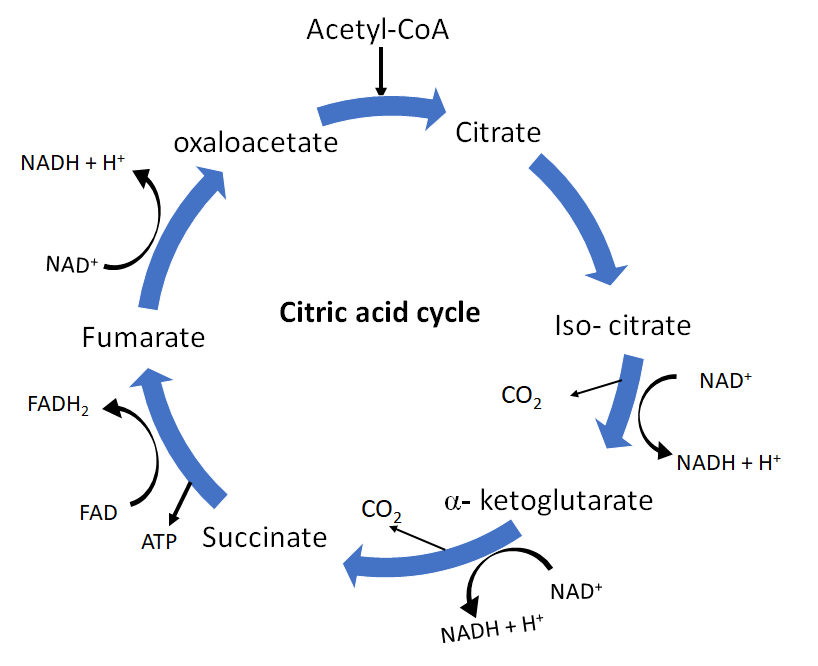
In one Krebs’ cycle, decarboxylation takes place at _______ steps.
(a) Five
(b) Four
(c) Three
(d) Two
Answer
578.4k+ views
Hint: Decarboxylation is the process of removal of the carboxyl group from a compound with the release of a carbon dioxide molecule. So, the number of steps in which a ${C}{O}_{2}$ molecule is released after removal of a carboxyl from a compound is the number of decarboxylation reactions in one Krebs’ cycle.
Complete answer:
Krebs’ cycle is the central pathway for the metabolism of carbohydrates, fats, and proteins. It begins with a citric acid molecule which is a 6- carbon compound and ends at Oxaloacetate which is a 4-carbon compound which indicates the removal of two carboxyl groups.
These carboxyl groups are removed with the release of a ${C}{O}_{2}$ molecule in two different steps.
- The first oxidative decarboxylation takes place at the fourth step of the TCA cycle where isocitrate is converted to 5-carbon α-ketoglutarate, with the release of a pair of hydrogen atoms and a molecule of carbon dioxide.
- The second oxidative decarboxylation occurs at the fifth step of the Krebs’ cycle where a molecule of coenzyme-A reacts with the α-ketoglutarate to form a 4-carbon compound succinyl- coenzyme A and releasing carbon dioxide and a pair of hydrogen atoms.

So, the answer is, “Two”.
Note:Decarboxylation is the reaction in which a carboxyl group is removed and it generally refers to the reactions of carboxylic acids. The reverse of this process in which there is an addition of a ${C}{O}_{2}$ molecule to a compound is called carboxylation and it is the first chemical step in photosynthesis.
Complete answer:
Krebs’ cycle is the central pathway for the metabolism of carbohydrates, fats, and proteins. It begins with a citric acid molecule which is a 6- carbon compound and ends at Oxaloacetate which is a 4-carbon compound which indicates the removal of two carboxyl groups.
These carboxyl groups are removed with the release of a ${C}{O}_{2}$ molecule in two different steps.
- The first oxidative decarboxylation takes place at the fourth step of the TCA cycle where isocitrate is converted to 5-carbon α-ketoglutarate, with the release of a pair of hydrogen atoms and a molecule of carbon dioxide.
- The second oxidative decarboxylation occurs at the fifth step of the Krebs’ cycle where a molecule of coenzyme-A reacts with the α-ketoglutarate to form a 4-carbon compound succinyl- coenzyme A and releasing carbon dioxide and a pair of hydrogen atoms.

So, the answer is, “Two”.
Note:Decarboxylation is the reaction in which a carboxyl group is removed and it generally refers to the reactions of carboxylic acids. The reverse of this process in which there is an addition of a ${C}{O}_{2}$ molecule to a compound is called carboxylation and it is the first chemical step in photosynthesis.
Recently Updated Pages
Why are manures considered better than fertilizers class 11 biology CBSE

Find the coordinates of the midpoint of the line segment class 11 maths CBSE

Distinguish between static friction limiting friction class 11 physics CBSE

The Chairman of the constituent Assembly was A Jawaharlal class 11 social science CBSE

The first National Commission on Labour NCL submitted class 11 social science CBSE

Number of all subshell of n + l 7 is A 4 B 5 C 6 D class 11 chemistry CBSE

Trending doubts
1 Quintal is equal to a 110 kg b 10 kg c 100kg d 1000 class 11 physics CBSE

What is Environment class 11 chemistry CBSE

Bond order ofO2 O2+ O2 and O22 is in order A O2 langle class 11 chemistry CBSE

How many squares are there in a chess board A 1296 class 11 maths CBSE

Distinguish between verbal and nonverbal communica class 11 english CBSE

The equivalent weight of Mohrs salt FeSO4 NH42SO4 6H2O class 11 chemistry CBSE




